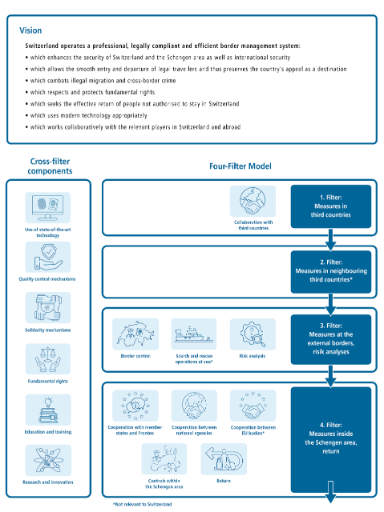The aim of Integrated Border Management (IBM) is to manage the Schengen external borders effectively, efficiently and systematically in order to make them more secure through better controls while keeping them as open as possible to legal travellers. IBM covers all operations for controlling the crossing of external borders, including addressing potential threats to these borders and combating illegal migration and cross-border crime. Since Switzerland is surrounded by Schengen states, it is not possible to leave or enter the country to or from a non-Schengen state by land. Switzerland’s external Schengen borders are therefore located at airports and airfields designated specifically for this purpose.
The European Commission's strategy for an integrated European border management and the technical and operational border management strategy of the European Border and Coast Guard, which is based on the European Commission’s strategy, provide the framework for the activities of the border management authorities of the Schengen area and for Switzerland’s IBM strategy with the multi-year policy cycle for European integrated border management (see Effective management of external borders).
Switzerland’s integrated border management strategy is based on the following vision: Switzerland operates a professional, legally compliant and efficient border management system, which enhances the security of Switzerland and the Schengen area as well as international security; which allows the smooth entry and departure of legal travellers and thus preserves the country’s appeal as a destination; which combats illegal migration and cross-border crime; which respects and protects fundamental rights; which seeks the effective return of people not authorised to stay in Switzerland; which uses modern technology appropriately and which works collaboratively with the relevant stakeholders in Switzerland and abroad.
The strategy identifies the necessity of having ready responses to the challenges expected up to 2028/29. Major factors to be considered in the coming years include increasing migration and mobility, heightened threat levels in public and internal security, hybrid threats, the perpetual reform of the Schengen Acquis, the increasing complexity and overlapping of border management tasks, and the rapid development of technology and its impact on processes. The strategy addresses these issues and endeavours to assess their impact on border management in the future.
IBM Strategy III seeks to implement Switzerland’s vision of integrated border management with 38 strategic objectives and relevant measures (in the Action Plan) in line with applicable standards and legal requirements.
The rolling action plan can be adapted to changes of context and in influencing factors whenever necessary.
Last modification 30.04.2024







